
Europe
Following in the tradition of Thomas Jefferson, whose library contained numerous works on European history, politics, and culture, the Library of Congress has many comprehensive European collections. The rarest of these works come to the Rare Book and Special Collections Division.
A special category of the division's European holdings is its collection of incunabula--books printed before 1501. Printed during the first decades of printing with movable type, these very rare and valuable books cover the whole spectrum of classical, medieval, and Renaissance knowledge and represent many of the highlights of the division's European materials. Over its nearly two-hundred-year history the Library of Congress has collected nearly 5,700 fifteenth-century books, the largest collection of incunabula in the western hemisphere. When Congress originally established its Library in 1800 and saw its collections destroyed by fire in 1814, it had no fifteenth-century books. Neither did the collection that Thomas Jefferson sold to Congress in 1815. This is not surprising because the books in the first Library served the need for general literature, and Jefferson primarily collected modern, scholarly editions in handy formats.
For the first fifty years or so after the acquisition of Jefferson's collection, the Library acquired incunabula very sparingly. The 1839 Catalogue of the Library of Congress lists only 2 incunabula: the Chronecken der Sassen (Mainz: Peter Schoeffer, 6 March 1492) and Ranulphus Hidgen's Polychronicon (Westminster: Wynkyn de Worde, 13 April 1495). The earliest incunabulum with a recorded date of acquisition is a 1478 edition of Astesanus de Ast's Summa de casibus conscientiae (Venice: Johannes de Colonia and Johannes Manthen, 18 March 1478). This volume, the gift of Obadiah Rich in 1840, is an example of the Library's serendipitous collecting of incunabula in the mid-nineteenth century.
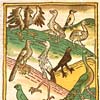
|
Konrad von Megenberg. Buch der Natur (Augsburg, 1481). A medieval Latin compendium of science that was edited and translated into German in the fourteenth century and was first printed in Augsburg in 1475. (Lessing J. Rosenwald Collection) |
The date that marks the real beginning of the incunabula collection at the Library of Congress is April 6, 1867, when the last shipment of Peter Force's library was received at the Capitol. His personal library held approximately 22,500 volumes, including 161 incunabula. The collection had some important books. The earliest imprint was Clement V's Constitutiones (Mainz: Peter Schoeffer, 8 October 1467); also included were a copy of Hartmann Schedel's Liber chronicarum (Nuremberg: Anton Koberger, 12 July 1493) and Jenson's printing of Pliny's Historia naturalis (Venice: Nicolaus Jenson, 1472).
That same year, the Smithsonian Institution deposited its important book collection for safekeeping in the Library of Congress, which had been fire-proofed following a disastrous fire in 1851. These books, including approximately 60 incunabula, are listed in the Library's 1868 catalog.

|
John Mandeville. Itinerarium (Augsburg, 1481). A book of pilgrimage, geographical lore, and marvels by a writer who is said to have made his eastern travels sometime toward the middle of the fourteenth century. (Lessing J. Rosenwald Collection) |
The next significant gathering of incunabula came in 1910 when the Library received on deposit the collection of John Boyd Thacher of Albany, New York. Thacher, following the example of earlier collectors of incunabula, collected specimens of the first or earliest work of fifteenth-century presses in order to demonstrate the diffusion of printing. Thacher set out to get at least one specimen from the over 1,000 identified presses in the fifteenth century. He was able to accumulate examples from approximately 500 of them. Shortly after his death, Emma Thacher deposited her late husband's collections at the Library of Congress. The deposit, later turned into a gift, had 904 incunabula, including 64 duplicates. Thacher's collecting method brought in major rarities, for instance Fust and Schoeffer's printing of Guillelmus Duranti's Rationale divinorum officiorum ([Mainz]: Johann Fust and Peter Schoeffer, 6 October 1459), as well as items unrecorded at that time.
![Thumbnail image of [Ulrich Richental]'s "Concilium zu Constanz" (Augsburg, 1483)](rat35001.jpg)
|
[Ulrich Richental]. Concilium zu Constanz (Augsburg, 1483). A contemporary account of the Council of Constance (1414---18), an ecclesiastical gathering that had grappled with questions of unrest and reform a century before the Reformation. (Lessing J. Rosenwald Collection) |
In 1926 the Library published a catalog listing important desiderata. The desiderata included 77 incunabula. In addition to a Gutenberg Bible and any fifteenth-century edition of the Columbus letter that announced the discovery of the New World, the list indicated the Library's need for a Mainz Psalter, the 1462 Fust and Schoeffer Bible, the 1476 Jenson Bible, editiones principes of Tacitus, Homer, and Aristophanes, and anything printed by the first English printer, William Caxton.
At this point Otto H. Vollbehr emerged from the wings. Vollbehr was a German industrial chemist turned book collector who at the close of World War I found himself with more assets than most. Either in his own collection or through consignment Vollbehr had control of thousands of incunabula. In 1926 Vollbehr came to the United States, bringing with him a collection of 3,000 incunabula to be exhibited at the Eucharistic Congress in Chicago. After the exhibition in Chicago, Vollbehr traveled with the collection by train to several other cities. His last stop was in Washington, and over 100 of the books were exhibited in the Great Hall of the Library of Congress. Vollbehr proposed that if a benefactor would step forward to buy the collection for an American institution for half the asking price of $1.5 million, he would donate the other half. In addition, he would include a complete copy of the Gutenberg Bible printed on vellum as one of the 3,000 incunabula.
The Gutenberg Bible which crowned Vollbehr's collection had had only three owners. The first owner was said to have been Johann Fust, who took it to Paris and sold it as a manuscript to a representative of the monks of Saint Blasius. It resided with the monks in the Black Forest until they had to move to St. Paul in Carinthia in the face of the Napoleonic army. Finally, in 1926, Otto Vollbehr purchased the three volumes from the monks for $250,000.
In December 1929, a bill was presented to Congress proposing that public funds be used to acquire the Vollbehr collection for the Library of Congress. In June 1930 Congress passed the bill and President Hoover signed it into law. Between July 15 and September 3 the Vollbehr books arrived at the Library of Congress. The Bible, one of three known perfect copies printed on vellum, is one of only a few items that are permanently on display in the Library.
The next giant step in collecting incunabula began in 1943 when the Library received the first installment of its greatest rare book gift--the Lessing J. Rosenwald Collection. Rosenwald began collecting prints in 1926, and his first major book purchases came in 1928 when he bought from A. S. W. Rosenbach a group of German illustrated incunabula, among them Die Cronica van der hilliger stat van Coellen [The Cologne Chronicle] (Cologne: Johann Koelhoff, the Younger, 23 August 1499) and Koberger's printing of Jacobus de Varagine's Legenda aurea sanctorum (Nuremberg: Anton Koberger, 5 December 1488). On the afternoon of March 5, 1929, he spent $404,700 at Rosenbach's on a variety of books, ranging from block books to William Blake. Early in 1930 Rosenwald returned to Rosenbach's and for $297,000 he bought 26 books that he knew would be available only once in a lifetime, including the 1488 Paris edition of Olivier de La Marche's Le Chevalier delibéré (Paris[Guy Marchand or Antoine Caillaut] for Antoine Verard, 8 August 1488), considered the finest illustrated French book of the fifteenth century.
![Thumbnail image of William Blake's "The Book of Urizen" (Lambeth: Printed by W. Blake, 1794 [i.e., 1815?])](rat39001.jpg)
|
William Blake. The Book of Urizen (Lambeth: Printed by W. Blake, 1794 [i.e., 1815?]). A retelling of the genesis myth, written, illustrated, and printed by William Blake. (Lessing J. Rosenwald Collection) |
In 1939 Rosenwald retired as chairman of the board of Sears, Roebuck and Company and began to fulfill his dream of involvement with philanthropy and developing his tastes as a collector. Both of these pursuits converged in 1943 when Rosenwald presented his collections to the nation, retaining possession of them during his lifetime. The prints were given to the National Gallery of Art and the books to the Library of Congress. The initial Rosenwald book donation numbered about 500 choice items. Of these, 200 were incunabula, 37 of which were not reported in other American collections. The gifts continued until Rosenwald's death in 1979. The catalog of the collection that the Library published in 1977 includes 2,653 entries, of which 559 are incunabula.
![Thumbnail image of Andreas Vesalius' "De humani corporis fabrica libri septem" (Basel, [1543])](rat37001.jpg)
|
Andreas Vesalius. De humani corporis fabrica libri septem (Basel, [1543]). A monument of the scientific revolution, this work marks the divide between antique and modern renderings of the human anatomy. (Lessing J. Rosenwald Collection) |
Whereas the Vollbehr collection contains in-depth representation of every aspect of fifteenth-century printing, the Rosenwald incunabula are books of outstanding importance in extraordinary condition. Of the 77 incunabula on the 1926 desiderata list, 5 were acquired in the Vollbehr purchase and 12 came through Rosenwald gifts. From Rosenwald the Library acquired Johannes Balbus's Catholicon (Mainz: [Epon. press (Johann Gutenberg?)] 1460), Fust and Schoeffer's 1462 Biblia latina (Mainz: Johann Fust and Peter Schoeffer, 14 August 1462), the edition of Dante's La Commedia (Florence: Nicolaus Laurentii, Alamanus, 30 August 1481) with copper engravings ascribed to Baccio Baldini, and two of the Caxton imprints on the list. Altogether Rosenwald had 16 Caxton imprints.
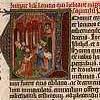
|
Biblia latina (Giant Bible of Mainz, 1452--53). A magnificent manuscript Bible which was written and illuminated in Mainz, Germany, around the same time that Gutenberg began the printing of his Bible. (Lessing J. Rosenwald Collection) |
The Rosenwald gifts brought the total number of copies of incunabula at the Library of Congress to nearly 5,700, where the count stands today.
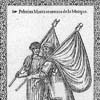
|
Nicolas de Nicolay. Discours et histoire véritable des navigations, pérégrinations et voyages, faicts en la Turquie (Anvers, 1586). Nicolay was the royal geographer during the reign of Henry II. He was part of an embassy to Constantinople in 1551; and his reports of scenes and customs are an important source of sixteenth-century Europe's knowledge of the Near East. (Lessing J. Rosenwald Collection) |
We can look at incunabula as a single category because of their importance for the history of printing and the dissemination of knowledge during the printing revolution, but these early printed books are complemented by the other European holdings in the Rare Book and Special Collections Division that are extremely broad, equally significant, and in many areas comprehensive. Obtained in various ways, some not easily characterized, and perhaps less striking to a general reading public, this material nevertheless survives on our shelves for scholars to consult in their efforts to reconstruct the historical landscape of Europe, especially if that landscape is conceived broadly enough to include the nooks and crannies as well as the wide vistas. The collections offer the researcher opportunities to delve into a wide spectrum of fields, such as Russian history and literature, the Reformation, the history of science, magic, individual writers and thinkers, and many other areas.
Most obviously for a comprehensive national library, the division's European collections contain important mileposts in the history of ideas. For instance, the division holds first or early editions of works by Herodotus, Plato, Lucretius, Augustine, Andreas Vesalius, Nicolaus Copernicus, Ignatius of Loyola, Francesco Guicciardini, Giorgio Vasari, Tycho Brahe, René Descartes, Willam Harvey, Jacques-Benigne Bossuet, Blaise Pascal, Giambattista Vico, Carl von Linne, Montesquieu, Edward Gibbon, Immanual Kant, Mikhail Lomonosov, Edmund Burke, John Keats, Fyodor Dostoyevsky, Jacob Burckhardt, Sigmund Freud, and Vladimir Nabokov.
Mention of only one of these authors will give the reader an idea of how we form some of our collections. The Library's Manuscript Division has been collecting the papers of Sigmund Freud for decades. In the 1970s the Rare Book and Special Collections Division began complementing these manuscripts with the selected purchase of Freud first editions and later revised editions. This collection of approximately 100 works contains a presentation copy of Freud's first book, Zur Auffassung der Aphasien (1891), and the first edition of his famous work Die Traumdeutung (1900). The division also collected more than 50 books from Freud's own library, most bearing indications of ownership.
When we look over the scene from a slightly different angle--from that of subject rather than that of author--the uses of the collections become readily apparent. Mention of Vesalius, Copernicus, and Linnaeus suggests the history of science as a fruitful area of research in our collections; and indeed our strengths in this area are broad and deep. In like fashion, add Bede and any number of other history writers to figures already mentioned--Herodotus, Augustine, Guicciardini, Bossuet, Vico, Gibbon, Burckhardt--and historiography and the philosophy of history become food for scholarly thought in the Library's rare book stacks.
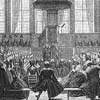
|
Cérémonies et coutumes religieuses de tous les peuples du monde (Amsterdam, 1728--43). A multivolume product of, and monument to, the anthropological ambitions and ecumenical appetites of the eighteenth-century West. |
Travel is a topic in which the Library's collections are especially rich. From the period of early travel, one may cite such works as the De consuetudinibus et conditionibus orientalium regionum [Antwerp, 1483--85], a version of Marco Polo's exploits; several fifteenth-century editions of the guidebook Mirabilia Romae; and the Peregrinatio of Bernhard Breidenbach, an account of pilgrimage to the Holy Land that appeared in both Latin and German versions in the same year (Mainz, 1486) and was soon thereafter rendered into other languages as well. The age of discovery is documented by the rich materials mentioned in the Americana section of this guide.
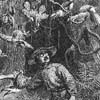
|
Henry Walter Bates. The Naturalist on the River Amazon (London, 1863). Bates was an expert collector of New World insects and the author of this famous description of the natural habitats of Amazonia. |
The coverage of discovery, exploration, and conquest remains impressive into the later stages of European expansion, for instance, James Cook's A Voyage towards the South Pole, and round the World (London, 1777) and Samuel White Baker's The Albert N'yanza, a Great Basin of the Nile, and Exploration of the Nile Sources (London, 1866). Also under the heading of travel and exploration the division holds an impressive variety of missionary accounts, ranging from Jesuit "relations" that begin to appear in the sixteenth century to works such as Pehr Hogstrom's Beskrifning offwer de til Sweriges Krona lydande Lapmarker (Stockholm, [1747]) and David Livingstone's Missionary Travels and Researches in South Africa (London, 1857). The technological transformation of travel is announced and chronicled in Barthelemi Faujas de Saint-Fond's Description des experiences de la machine aerostatique de MM. de Montgolfier (Paris, 1783--84). Three collections in the division focus on the history of travel: the John Boyd Thacher Collection and the Hans and Hanni Kraus Sir Francis Drake Collection contain rich material on the European intrusions into the wider world and on the competitions and contests among the European powers that joined in the conquests, and the Jefferson Patterson Collection has numerous nineteenth-century travel accounts. The Thacher Collection is also wide-ranging in other European material, two of its principal subjects being the European discovery of America and the history of the French Revolution. This collection also contains rich holdings of manuscripts of European notables with items dating from the early fourteenth century.
Also devoted to European materials, the Reformation Collection and the Luther Collection are small gatherings of material relating to sixteenth-century religious upheaval. Their principal but not exclusive strength is their number of Luther imprints, and their significance increases when they are placed in relation to other material in the division. The wide range of sixteenth-century material in the Lessing J. Rosenwald Collection, the Medieval and Renaissance Manuscript Collection, and the Library's immense collection of incunabula provide intellectual background to Reformation and Counter-Reformation currents of thought as well as material for assessing the crossover from medieval to modern culture and the coincident metamorphosis of a manuscript culture into a culture of print. Moreover, materials directly related to the Reformation collections are to be found in the general collections of the division. Early vernacular Bibles located outside of the Luther and Reformation Collections also have an obvious bearing on them.
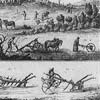
|
Encyclopédie, ou Dictionnaire raisonné des science. (Paris, 1762). The single most revealing summation of Enlightenment ideas and attitudes. |
Other European collections focus on the histories and literature of peoples defined largely by national language. The Accademia della Crusca Collection contains Italian publications ranging from the sixteenth to the nineteenth centuries. The 1929 purchase of the Raymond Toinet Collection brought to the Library 2,500 volumes especially strong in seventeenth-century French literature. The Francis Longe Collection is a gathering of theatrical works printed in English in the period from 1607 to 1812. In the early 1930s the Library purchased 2,600 volumes from the book collections of the Romanov family. This Russian Imperial Collection reflects the reading interests of the Russian imperial family and the types of books they received as gifts. Also in the category of Russian history and literature is the Yudin Collection, purchased in 1906. Of the 80,000 volumes originally in the collection, the division houses approximately 4,000 of the rarest. Included are Dostoyevsky's first published novel Biednye liudi (Poor people) (1847) and the first edition of A. N. Radishchev's critique of serfdom Puteshestvie iz Peterburga v Moskvu (A Journey from Saint Petersburg to Moscow) (1790), in which the author cites the 1776 Pennsylvania constitution on freedom of the press. The Early Bulgarian Imprint Collection contains approximately 600 books published while Bulgaria was under Turkish domination. Printed outside Bulgaria, these books helped keep the Bulgarian printed word alive during the period in which the Turks prohibited printing presses.
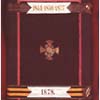
|
Strielki im peratorskoi familii. Istoricheskii ocherk (St. Petersburg, 1899). A history of the czar's regiment bound in a hussar's uniform with ribbons of the orders of St. Andrew and St. George. (Russian Imperial Collection) |
Other collections are arranged around the printed record of individual authors. The Danish actor Jean Hersholt presented the Library with a magnificent collection of first editions, manuscripts, and other material related to Hans Christian Andersen. This is the most comprehensive collection of Anderseniana in America. The Library formed its extensive collection of the writings of Rudyard Kipling through the donations of William Montelle Carpenter, Rear Admiral Lloyd H. Chandler, and Mrs. H. Dunscombe Colt. This gathering includes autograph manuscripts, letters, corrected galley proofs, and many early editions. Included are the earliest known draft of "Mowgli's Brothers," the first story in The Jungle Book, and a set of dessert plates on which Kipling painted fruit and wrote verse. Similar author collections include holdings of the writings of Cervantes, Jules Verne, and Hugh Walpole.
An interesting collection bearing upon twentieth-century history is the Third Reich Collection brought to the United States after World War II and including books from Adoph Hitler's library as well as from Nazi leaders Himmler, Goering, and others.
Several other collections, principally of a subject nature, have considerable concentrations of both European and American material. George Fabyan, an eccentric cryptographer, bequeathed his collection to the Library in 1940. The collection includes significant works on cryptography as well as material relating to the Shakespeare-Bacon controversy. It also has important English and continental printed items from the sixteenth and the seventeenth centuries including two copies of the earliest edition of Johann Trithemius's Polygraphia (1518) and five editions, beginning in 1606, of his Steganographia. The John Davis Batchelder Collection, given to the Library in 1936, has a particularly broad historical sweep, touching many of the bases of printed history. It includes such items as the accounts of discovery in De insulis nuper inventis ... narrationes (Cologne, 1532); Camille Desmoulins's La France libre ([Paris], 1789); Walt Disney Productions' Three Little Pigs [Braille edition] (New York, 1934); and the Japan Advertiser's Enthronement of the One Hundred Twenty-fourth Emperor of Japan (Tokyo, 1928).
Both the Katherine Golden Bitting Collection on Gastronomy and the Elizabeth Robins Pennell Collection are primarily concerned with gastronomy and the history of the kitchen and, between them, have gathered together several thousand European and American imprints. The Bitting gift, for instance, includes an Italian manuscript written about 1450, entitled "Libro de arte coquinaria composto per lo egregio maestro Martino," which in Latin translation appears as part of Platina's De honestate voluptate (1474), considered to be the first printed cookbook. Bartolomeo Scappi's Opera (Venice, 1605), with illustrations showing a fifteenth-century kitchen, Columella's Les douze livres des choses rustiques (Paris, 1556), Tobias Venner's Via Recta ad vitam longem (London, 1638), and the first American edition of One Thousand Valuable Secrets in the Elegant and Useful Arts (Philadelphia, 1795) provide a variety of gastronomic information.
Two significant gifts relating to magic and spiritualism also display the divisions broad range of collecting. Harry Houdini bequeathed to the Library in 1926 approximately 4,350 books, pamphlets, and periodicals dealing with magic and the psychic. Included are manuscripts, newspaper clippings, posters, programs, catalogs, and other ephemera. In this collection we find such rarities as the second edition of Hocus Pocus Junior (London, 1635); an English translation of Giovanni Battista della Porta's Magica naturalis (London, 1638); Simon Witgest's Naturalisches Zauber-buch (Nuremberg, 1740); and Breslaw's Last Legacy; or The Magical Companion (London, 1791). The McManus-Young Collection of magica donated in 1955 further strengthened the Library's holdings in this field.
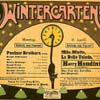
|
Wintergarten Poster (6 April 1901). This poster dates from the period of Houdini's early European successes. Visually rich, it also documents the international, highly diversified context within which the magician performed. (McManus-Young Collection) |
We should make some mention of the division's Bible Collection, which holds many items in 150 languages from the fifteenth to the twentieth centuries. This splendid gathering helps to document the history of ideas, of religion, of art, and of printing and book illustration--part of the cultural history of modern Europe and other cultures. The size of the collection is impressive, but more striking are individual items that qualify as gems. These include the Complutensian Polyglot Bible (6 vols. [Alcala, 1514---17]); the edition of the Greek Bible, done at Venice in 1518, which was the editio princeps of the complete Greek text (if one excepts the Alcala polyglot, which was not issued until 1520); a sixteenth-century edition (Lugduni, 1543) of Peter Comestor's Historia scholastica; and the Eliot Indian Bible, the first Bible printed in America (1663). A recent addition to this collection is a spectacular 1702 Dutch Bible with over 160 hand-colored engravings by Romeyn de Hooghe, perhaps the greatest Dutch engraver and book illustrator of the latter part of the seventeenth and beginning of the eighteenth centuries.
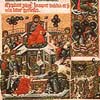
|
Nekcsei-Lipocz Bible. Latin Bible probably written and decorated in Hungary, ca. 1335--40. |
While rich European materials, manuscript and printed, are to be extracted from specific collections that can be identified as essentially "European" in character as well as from the general divisional holdings, there still remain European materials of a high order and of not negligible quantity in other specific collections that might go uncombed because of their essentially American character.
Perhaps the clearest example of this is the Jefferson Library, the foundation collection of the congressional library. At the time of its purchase in 1815, complaints were heard that Jefferson's shelves "had too many books in foreign languages." And indeed, in its books of history and political economy and in its texts and translations of the ancient classics, Jefferson's library, by its character and range and by the variety of the languages in which its books are written, reflects a library of a typical reader of the European Enlightenment, whether in fact such a figure lived on the continent or in the backwoods. Jefferson's copy of Louis Cousin's Histoire de Constantinople (8 vols.; Paris, 1685), a quite rare work in today's world and market, is only one example of the European surprises that American collections can hold.
Another, from the Franklin Collection, is Benjamin Franklin's own copy of Pierre Simon Fournier's De l'origine et des productions de l'imprimerie primitive (Paris, 1759). The Theodore Roosevelt Hunting Library holds a copy of Jean de Clamorgan's La Chasse du loup (Paris, 1566) and a copy of Robert de Salnove's La Venerie royale (Paris, 1655), to mention only two examples of Roosevelt's copies of European books concerning the wilds. The Woodrow Wilson Library Collection and the Oliver Wendell Holmes Library Collection also hold items significant to the history of European thought and civilization.
Rare Book and Special Collections in American Memory
Library of Congress Home Page
 Library of
Congress
Library of
Congress